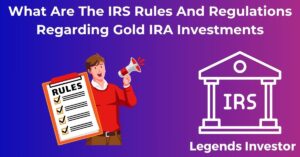A Gold IRA, officially known as a Precious Metals IRA, is exactly like a regular individual retirement account, but it holds physical gold or other precious metals instead of traditional assets like stocks or bonds. This type of retirement plan has been growing in popularity in recent years.
You might wonder why anyone would swap out stocks for shiny rocks, right? Well, folks see gold as a solid hedge against inflation and economic uncertainty. Unlike paper currency, gold holds intrinsic value, making it an attractive asset for long-term stability.
Gold IRAs aren’t your regular retirement savings vehicle. Instead of just stashing away cash or picking up a few mutual funds, you’re actually investing in something tangible. We’re talking gold bars, bullion, and even certain approved coins. It’s a different ball game from those digital numbers in your bank account!
Now, don’t go thinking you can just toss gold coins into a shoebox under your bed and call it a day. Gold IRAs require a custodian to manage and store those physical assets safely. This ensures that stringent IRS rules and regulations are followed, keeping your investment legit and above board.
Deciding to invest in a Gold IRA is like choosing your own adventure—instead of a diversified mix of stocks and bonds, you get to wander into the wilder world of precious metals. It takes a different mindset and approach, but for those keen on tangible assets, it could be a journey worth embarking on.
Mechanics Explained: How Does a Gold IRA Work?
Gold IRAs operate like your regular IRAs on the surface, but look a bit closer, and you’ll spot some unique features. First up, to get started, you need a special type of custodian, one that’s got the knack for handling and securing precious metals. These custodians are crucial because they manage the legalities and logistics of storing those gleaming assets on your behalf.
During the setup, you’re usually rolling over or transferring funds from an existing retirement account into your brand spanking new Gold IRA. This involves opening the account with a custodian who teams up with a depository, ensuring your gold is not just safe but IRS-approved secure.
Once your funds have made the leap into your Gold IRA, you have the exciting task of choosing which shiny treasures to buy. Options typically include gold bars, bullion, or select coins, all complying with strict IRS purity standards. It’s like shopping for treasure, where every piece could be a key part of your retirement fund.
One crucial piece of advice here is to keep a close eye on fees during the whole process. They can sometimes sneak in like uninvited guests, and if you’re not careful, they can nibble away at that golden stash. Every custodian and dealer structure fees differently, so make sure everything’s crystal clear before making a move.
A thoughtful approach to investing in tangible assets like gold requires understanding both markets and global economic trends. Gold prices can fluctuate based on a bunch of factors, from geopolitical tensions to shifts in currency values. So, a gold IRA isn’t about a quick win but rather a steady, long-term strategy that, if played right, can offer a stable and secure addition to your retirement portfolio.
Diverse Options in Gold IRAs
When it comes to Gold IRAs, you’ve got some choices to make, and it’s not just about gold coins or bars. Various types of precious metals can be part of the mix, including silver, platinum, and palladium. Each metal comes with its own market behavior and investment potential, making diversification a real opportunity within the metal category itself.
Now, if you’re the type who likes to have a say in every part of your investment, a self-directed Gold IRA might catch your interest. This type lets you go beyond just gold, giving you control over buying different precious metals as part of your retirement strategy.
In figuring out which type of Gold IRA is right, comparing it with other gold investment avenues is key. Some might choose to invest in mutual funds or ETFs that offer exposure to gold without having to deal with physical metals. However, these options don’t provide the satisfaction or security of owning something tangible.
As you explore, consider the role each metal plays in economic shifts. For instance, gold is often seen as a classic hedge, while silver has both industrial use and investment appeal. Platinum and palladium tend to be more volatile due to their dependency on industrial demand, particularly in automotive and electronics sectors.
Choosing the right mix within your Gold IRA can maximize potential gains while minimizing risks. A diverse metal portfolio could provide a balanced approach between stability and growth, aligning with long-term retirement goals.
Engage with reliable gold IRA investing companies that offer good advice on precious metal portfolios. Their insights can guide you through understanding these metals’ roles in the broader economic context and help you make informed decisions with confidence.
Advantages and Disadvantages of a Gold IRA
Gold IRAs have their perks, but they also come with some strings attached. Let’s break down the positives first: gold is often a go-to for folks looking to hedge against inflation. When the dollar’s purchasing power starts taking a dip, gold tends to hold its own, which can help preserve wealth over the long haul.
Diversification is another big plus. Adding gold and other precious metals to your retirement portfolio means you’re not putting all your eggs in one basket. If the stock market hits a rough patch, gold might just be your safety net.
Now, onto the less shiny side of things. One downside is market volatility. Gold prices can swing up and down based on global events and economic trends. This means a Gold IRA might not always provide the stable ground some investors hope for.
Then there’s the whole deal with storage and insurance. Physical gold needs to be stored safely, driving up costs that other IRA types don’t really require. You can’t just stash it in your basement; it’s got to be stored in an IRS-approved depository for both security and compliance.
The initial setup fees and ongoing account maintenance charges for a Gold IRA also tend to be higher compared to traditional IRAs. This is something you’ll want to weigh carefully, as fees can eat into what might otherwise be solid returns.
Reading up on real-world experiences and Gold IRA reviews can provide personal insights into these advantages and disadvantages. Everyone’s financial situation and goals are unique, so what’s good for one person might not suit another.
Pros and Cons of Gold IRA
Diving into the world of Gold IRAs means weighing the good with the not-so-great. On the pro side, investing in a Gold IRA offers a hedge against inflation, which is pretty reassuring. When traditional markets get shaky, having a tangible asset like gold can keep things steady.
Another appeal is diversification. By adding precious metals to a retirement portfolio, you’re not just banking on stocks or bonds. This means when one market feels the heat, another might just be cool enough to balance things out.
The security of physical gold is another pro. There’s something grounding about having a real, tangible asset stored and safeguarded as part of your future plans.
But let’s talk cons. For starters, gold’s market can be unpredictable. Prices are affected by everything from geopolitical tensions to local regulations. That can make it a roller coaster for those not ready for the ride.
Storage and insurance costs are more considerations. While your gold’s safe in a depository, there’s a price tag attached. These costs can add up, potentially chipping away at the overall returns from your Gold IRA investments.
Research on Gold IRA investment companies reveals varying levels of service and reliability. Choosing the best gold IRA company involves digging into reviews, understanding the fee structures, and ensuring they fit with your investment philosophy.
Even though Gold IRAs aren’t for everyone, for the right person, they could offer a level of security and diversification that complements more traditional investment plans.
Mitigating Financial Risks Associated with a Gold IRA
Investing in a Gold IRA isn’t without its risks, but understanding these can help you navigate them better. Market fluctuations are a major consideration. Gold prices can be influenced by a myriad of factors, including political instability, currency shifts, and economic policies. Keeping an eye on global events can help in anticipating these price swings.
The risk of theft or loss is minimized thanks to the IRS requirement that gold be stored in approved depositories, which are highly secure. However, this security comes at a cost, and it’s essential to factor in these expenses when considering your potential net gain.
Liquidity might also be an issue. Unlike stocks, which can be sold quickly, offloading physical gold takes more time and effort, and you might not always get your desired price. This could impact your ability to react swiftly to urgent financial needs.
Counterparty risk is another element to consider. This is the risk that the custodian managing your Gold IRA might face financial failure, impacting your investment. Researching and choosing a reputable custodian can lessen this particular risk significantly.
Mitigation strategies can include diversifying within your Gold IRA by holding a mix of different precious metals and keeping a keen eye on global market trends. Also, maintaining a clear understanding of all associated fees and risks upfront can prevent unpleasant surprises along the way. With these tools in hand, navigating the Gold IRA investing landscape becomes much more manageable.
What are the Fees of a Gold IRA?
Understanding the fees tied to a Gold IRA is crucial for managing potential returns. These can vary widely between providers, so it’s important to break them down to see what you’re getting into.
One of the initial expenses you’ll encounter is the setup fee. This charge is incurred when first opening your Gold IRA account, and it can range from modest to quite substantial depending on the chosen company. Some providers offer promotions that waive this fee, so it’s worth shopping around.
Annual maintenance fees are a recurring cost you can’t ignore. These cover the administrative efforts required to manage and report on your Gold IRA. Fees here can vary, so check multiple gold IRA reviews to find a company that’s upfront and reasonable with their charges.
Storage fees are another major consideration. Since physical gold needs to be securely stored, you’ll be paying a depository to keep your assets safe. Fees depend on the amount of gold held and the type of storage, with options for segregated or non-segregated accounts. Choose wisely based on your security preference and budget.
Transaction fees pop up whenever you purchase or sell precious metals within your IRA. These can also add up, so understanding a company’s buy-sell spread is important. It’s advisable to look for transparency on these costs to avoid any surprises.
Lastly, there could be fees for fund transfers or account termination. Always read the fine print and ask questions to clarify any charges that aren’t immediately evident.
Being aware of all potential fees equips you to make better decisions and budget more effectively for your retirement planning.
How to Open a Gold IRA Account
Opening a Gold IRA account involves a few clear steps that ensure you’re on the right track to secure your financial future with precious metals. First, you’ll need to find a reliable custodian. This is a company authorized to manage Gold IRAs, and their role includes both acquiring and storing your metals safely.
Start by researching well-rated gold IRA companies. Check reviews, compare fee structures, and understand their customer service offerings. It’s all about finding the best gold IRA company that aligns with your expectations and provides robust gold IRA advice.
Once you’ve picked your custodian, opening the account involves an application process similar to traditional IRAs. You’re essentially filling out forms and transferring funds from an existing retirement account or making new contributions. It’s often easiest to roll over funds from an existing 401(k) or IRA into your new Gold IRA.
After your account is ready, it’s time to decide on the type of gold or other precious metals to include. Your custodian should provide a list of IRS-approved metals you can invest in. Whether you’re picking up gold bars, bullion, or select coins, ensure the choice aligns with both market trends and your risk comfort.
Finally, think about ongoing account management. You’ll need to check in on your investment’s performance and market conditions regularly to optimize gains and balance risks.
Before diving in headfirst, get clear on all the involved transaction and maintenance fees to avoid unexpected surprises. Working closely with your custodian for informed decisions will make sure everything’s in place for a smooth journey in gold IRA investing.
Conclusions: Is a Gold IRA Right for You?
Deciding whether a Gold IRA fits into your retirement strategy depends on a blend of personal goals, risk tolerance, and market outlook. For those who value tangible assets and view gold as a stable option amidst economic ups and downs, a Gold IRA could provide the desired financial security.
Gold’s track record as a hedge against inflation and currency devaluation adds weight to its appeal for those cautious of volatile markets. If your financial plan embraces diversification and you’re comfortable with the long-term storage and fees involved, then these assets might complement your broader investment strategy.
On the flip side, if you’re uneasy with the market swings or the commitment to physical storage and related costs, it might be worth exploring other investment vehicles. Gold IRAs aren’t inherently right or wrong—they’re just one of many avenues available for setting financial goals.
Consider your full financial picture. Are you looking for growth, security, or both? Think about whether potential gold price increases fit your retirement timeline and financial needs. It’s always wise to consult with financial advisors who specialize in precious metals to get tailored input based on your unique situation.
In sum, a Gold IRA might be the treasure chest for some, while others prize the rapid growth possible in more volatile markets. Exploring your options thoroughly ensures that whatever choice you make is well-informed and aligns perfectly with both your present circumstances and future ambitions.



